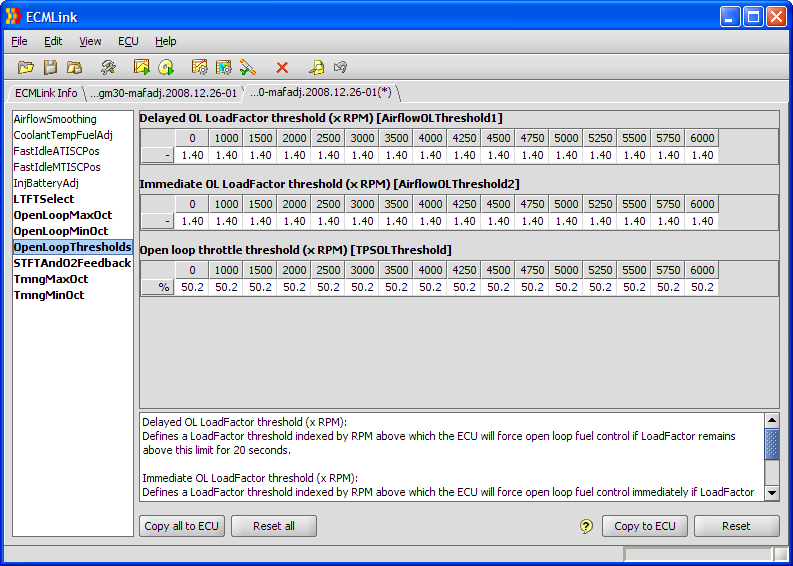This is an old revision of the document!
Table of Contents
MAF Adj: CombinedFT
The MAF Adj: CombinedFT menu item is one of several tools you can use to help “dial in” your airflow settings. This particular item maps out and averages CombinedFT over a range of closed loop driving conditions to produce a set of adjustments to the current MAF compensation table. It's basically letting the ECU track how much adjustment it needs under various conditions and then moves that adjustment into the MAF compensation table.
This function probably helps most with a GM MAF setup run straight to the ECU using ECMLink's GM MAF integration option. That particular configuration produces a pretty large number of MAF sample points for fairly typical driving conditions (easily ranging from 500hz to 2000hz for simple idle and cruise conditions). So having a tool which helps establish a decent starting point can be very handy here.
Initial requirements
You absolutely MUST make sure your fuel settings are already appropriate for your injector size, fuel type and base fuel pressure. If there is any deviation here, then the adjustments to airflow suggested by this function will simply include those fuel corrections as well! This can create a really confusing configuration if you aren't careful. So please review your global fuel and deadtime settings first to make sure they are at least somewhat reasonable for your setup.
Make sure the car is able to run in closed loop mode. Look for a cycling FrontO2 sensor and a “1” in the ClosedLoop log item. It doesn't have to be running with fuel trims near 0% (that's the purpose of using this function after all). But it does need to at least cycle in closed loop mode on its own. If it does not, you need to make some manual adjustments first to at least get it running in closed loop.
A good understanding of CombinedFT and fuel trim in general will help a lot with your understanding of this function.
Add the following log items to your captured values: CombinedFT, MAFRaw and ClosedLoop
Make sure the engine is at full operating temperatures. You don't want to mess with coolant based various at this point. You want to stabilize everything you can first and then adjust based on the one variable left (presumably airflow variation).
Basic Usage
Once you're satisfied that the requirements above have been met, you're ready to grab a datalog. Let the car idle for about a minute. Then go drive. Try to keep the car in closed loop mode as much as possible (more on that in the advanced section). When you're done, you can click on the MAF Adj: CombinedFT menu item to see what the application comes up with. Review this, smooth the points as you'd like, extend the points to cover areas where you did not collect data and then hit “Save to ECU” when you're done.
NOTE: You're basically changing the very data long term fuel trim was previously based on. So if you're making fairly large changes to MAF compensation, you should consider resetting the long term fuel trim values using the “Reset fuel trims” menu item in the ECU menu.
Advanced Usage
Because this function operates only during closed loop mode, it's handy to try to extend closed loop mode as much as possible so that you get a wider range of data in your logs. This will produce a larger number of auto-adjustments to the airflow curve for you.
There are several ways you can extend closed loop conditions. The easiest of which is to simply edit the DirectAccess tables that control when open loop is triggered. By moving those open loop trigger points “higher”, you extend the conditions under which closed loop mode will be maintained by the ECU.
The image below shows a fairly typical setup for the various open loop threshold tables you can use to extend closed loop mode for this test. Keep in mind what you're doing here, though. You're basically telling the ECU to maintain stoich air fuel ratios under more load (LoadFactor) and with more throttle. This could very well produce a hotter mixture than you'd like to maintain for any lengthy period of time. So monitor EGTs if possible or if not, just try not to stay under high load/closed loop mode for very long.
With that table in place, you can grab a datalog with a bit more load variation. Personally, I like to find a nice hilly area and apply light throttle to vary LoadFactor between 0.9 to 1.3 while maintaining closed loop operation. This driving combined with the typical flat road driving (with LoadFactors around 0.6-0.9), combined with typical idle and free rev (LoadFactors around 0.3-0.4) really produces a good set of data for this function.
Sample Calibration
I'll walk through a sample calibration of my own car below. This is a 1995 AWD Talon with 850 injectors running E85 and a GM 3“ MAF connected to the ECU. The MAF is installed just before the throttle body using upper IC piping that has flared 3” ends as shown below.
« insert picture when I finally remember to bring the @$!%$!$ memory card in »
Download the datalog below to review the initial driving cycle and setup. The things to note include the global fuel setting and the MAF compensation.
Initial drive cycle and setup log
Global fuel is set appropriately for 850s on stock base pressure running E85 using the following formula:
100% E85 Global Adj = 1.5 * Stock Injector Size / New Injector Size - 1 100% E85 Global Adj = 1.5 * 450 / 850 - 1 = -0.206 or -20.6%


